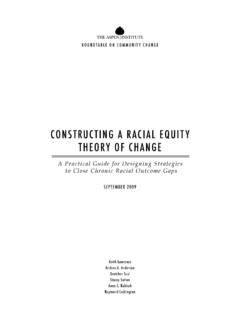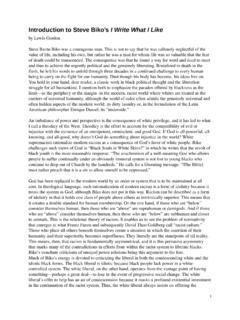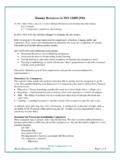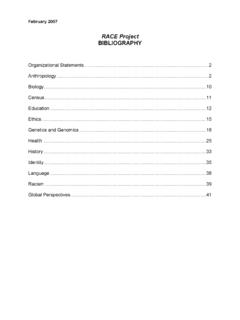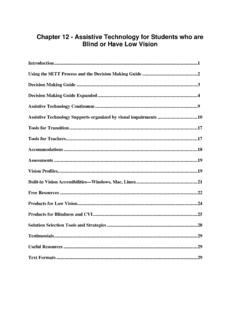Transcription of W H I T E N E S S 1 0 1 : F O U N D A T I O N A L P R …
1 WHITENESS 101: FOUNDATIONAL PRINCIPLES EVERY WHITE BRIDGE BUILDER NEEDS TO UNDERSTAND CONTENTS INTRODUCTION 3 GLOSSARY OF TERMS 5 ADDRESSING THE FOUR W'S 6 STEP 1: DEVELOPING A WHITE IDENTITY 7 STEP 2: ACKNOWLEDGING WHITE PRIVILEGE 9 STEP 3: OVERCOMING WHITE FRAGILITY 11 STEP 4: RECOGNIZING WHITE SUPREMACY 13 BONUS SECTION: 16 BRIDGE BUILDING TIPS FOR WHITE PEOPLE 17 WHERE DO I GO FROM HERE? 19 Unless otherwise indicated, all Scripture quotations are taken from the Holy Bible, New Living Translation, copyright 1996, 2004, 2007, 2013, 2015 by Tyndale House Foundation. Used by permission of Tyndale House Publishers, Inc., Carol Stream, Illinois 60188. All rights reserved. 2017 BE THE BRIDGE 2. INTRODUCTION. Close your eyes and picture a racially reconciled body of believers. What do you see? The image in your mind might resemble what the apostle John described in Revelation 7:9: I saw a vast crowd, too great to count, from every nation and tribe and people and language, standing in front of the throne and before the Lamb.
2 What an inspiring picture! This is no homogenous group, but rather a colorful collection of communities, singing their praises to God in their own heart languages. We will carry our culture and ethnicity with us into heaven, and God will be glorified through the diversified expression of our unified praise. This vision of the future provides insight about the kind of church we should strive to create in the present. Jesus taught us to pray that believers would mirror this reality on earth, just as it is in heaven (Matthew 6:10). But how do we bring this heavenly reality to earth? In a perfect, sinless world we would simply lock arms, love one another, and worship our risen Savior in perfect unity. We would see each other as image bearers of a loving God: each unique and beautiful, revealing the infinite, limitless nature of our God. But we do not exist in that world. We exist in one ravaged by sin: our lust for power and control, our fear of those different from us, our greed and materialism, our need to denigrate others so we feel better about ourselves, and our propensity to lie in an attempt to cover up our guilt and shame.
3 We have made idols of safety, order, power, wealth, comfort, and success, instead of living out God's commandments to love Him above all and to love our neighbor as ourselves. All of this has contributed to the current state of racial hostility in our world, in our county, and in the church. Jesus came into the world to reconcile the world to Himself and to reconcile formerly hostile communities to one another (Ephesians 2; 2 Corinthians 5). Jesus entrusted this ministry of reconciliation to the church. Racial reconciliation is not an optional aspect of the church or a niche issue reserved only for more liberal congregations; racial reconciliation is central to the church's gospel mission. The church cannot whittle down racial reconciliation to an annual sermon series or an optional church committee. We can no longer push the topic away because it's too political. If the American church remains segregated, and cannot or does not resolve to embody racial reconciliation as a model of heavenly unity in diversity, we fail in our effort to be a credible witness to the power of the gospel.
4 2017 BE THE BRIDGE 3. Historically, the burden of racial reconciliation work in our country has disproportionately fallen on the shoulders of people of color. As white people, it is past time for us to begin sharing this burden. Racial reconciliation is difficult work. Racial hostility and segregation do not dissolve by coming together for a group hug, embracing colorblind ideology, or ignoring the sins of our past. Reconciliation begins when we say, I won't stay silent and let the sin of racism ravage what God created as good (racial and ethnic diversity). Reconciliation continues when we empty ourselves of our pride, as well as our need to be right, to be heard, or to feel understood. Racial reconciliation work will rip your soul into pieces and flip your worldview upside down. It is slow work that requires commitment, prayer, and sacrifice. As white people, we often want to jump into the work of racial reconciliation with guns blazing, ready to speak out and fix everything!
5 But we must learn that our first step is to engage in the disciplines of quiet self-reflection and learning. This way, when we go to our brothers and sisters of color to reconcile, we will come from a healthy place a truthful place where real and sustainable change and reconciliation can happen. Whiteness 101 will walk us through some of that initial learning and self-reflection. It may be used as a guide for private, individual study. However we highly recommend gathering a group of white friends and working through the reading and exercises together. 2017 BE THE BRIDGE 4. GLOSSARY OF TERMS Let's define some terms. Conversations surrounding race often go awry simply because one or both parties have an incorrect or incomplete understanding of words and their meanings. Here are introductory definitions of some key words and, in some cases, resources for further learning on that topic: ETHNICITY Ethnicity is a social classification of humans based on their common culture, heritage, nationality, religion, language, and/or other similar categories.
6 The term is derived from the Greek word ethnos, which in the Bible is often translated tribe or people group. IMPLICIT BIAS The Kirwan Institute defines implicit bias as the attitudes or stereotypes that affect our understanding, actions, and decisions in an unconscious involuntarily, unconsciously, and without one's awareness or intentional control. Article: NCSC's Frequently Asked Questions About Implicit Bias PEOPLE OF COLOR People of color (often abbreviated POC ) is the preferred term for non-white people or communities. PREJUDICE Prejudice is a preconceived judgment or opinion about a person or group of people, usually based on limited information and stereotyped generalizations. Article: Toward an Understanding of Prejudice and Racism RACE Race is the social classification of humans into categories based on a broad range of physical characteristics such as skin color, facial features, and hair texture. Racial categorization is not based on science, but on arbitrary distinctions which have shifted over time.
7 Widespread usage of the concept of race did not occur until the 17th century, when European colonizers sought a way to legitimize a social hierarchy that placed light-skinned people in power and allowed for the subjugation of all others. Article: What Scientists Mean When They Say Race is Not Genetic RACISM Racism is a system of advantage based on race, involving cultural messages, misuse of power, and institutional bias, in addition to the racist beliefs and actions of individuals. Video: 5 Things You Should Know About Racism WHITE PEOPLE White people is the term used to describe Caucasian people or communities, or those of European descent. 2017 BE THE BRIDGE 5. ADDRESSING THE FOUR W'S: WHITE IDENTITY, WHITE PRIVILEGE, WHITE FRAGILITY, AND WHITE SUPREMACY Conversations surrounding race in America are fraught with contentious rhetoric. On all sides of the issue, there is hurt, distrust, and misunderstanding. White people are often at a disadvantage in discussions about race, because most of us are not fluent in the language of race.
8 For many of us, the few conversations about race we have been a part of were not positive or constructive. It's common for white people to arrive at adulthood without ever participating in an in-depth discussion about race. Then, when we do attempt to dialog about race, we quickly learn that there are racial concepts and terminology unfamiliar to us. All of these things can leave us feeling insecure about how to begin let alone sustain a conversation on race. People of color are often shocked to discover that a majority of white people rarely, if ever, talk about race, especially as it relates to their own identity. In other words, we don't often talk about what it means to be white . Not having to think about our racial identity is a very white experience. Most people of color are forced to consider their racial identity multiple times a day, every day. While Americans of color vary along a spectrum of healthy awareness of their racial and ethnic identity, most do not make it far in life before being confronted with at minimum the reality that they are not white.
9 From an early age, they begin learning about what it means to be (or not to be) white. Therefore, people of color often have a much deeper understanding of whiteness than white people do! This isn't necessarily a criticism of white people. We simply don't know what we don't know. As white people, we usually have the ability to order our lives so that we never have to interact with people from other races. People of color haven't had that option. In order for us to competently enter into constructive conversations on the topic of race, we've got some catching up to do. Over the next pages, we'll attempt to help you bridge some of that knowledge gap by exploring what we call The Four W's : white identity, white privilege, white fragility, and white supremacy. A full understanding of these concepts will require a lifetime of learning. However our goal is to provide some basic onramps to get you started on your bridge-building journey. NOTE: Throughout this document, we've included many hyperlinks to recommended resources for continued learning on these topics.
10 2017 BE THE BRIDGE 6. STEP 1: DEVELOPING A WHITE IDENTITY If you were to write down five words to describe yourself, how likely would you be to include white on the list? Highly unlikely, right? This is because to be white in America is to be a part of the dominant, or default, culture. It's quite common for us to grow up as white people, believing we don't have a culture. Culture is what other groups of people have. We admire their colorful dress, their spicy foods, their exotic-sounding language. We feel we don't have anything special; we're just normal. For instance, hair care products for white people fill an entire aisle in Target, which is simply labelled, hair care. But then Target may have a small, separate section for ethnic hair care. Why? Because hair products for white people are the norm. They are simply hair care, not hair care for _____ people. We generally define ourselves (and others) by the parts of our identity that are subordinate (or non-dominant), while the dominant aspects of our identity remain invisible or unexamined.
